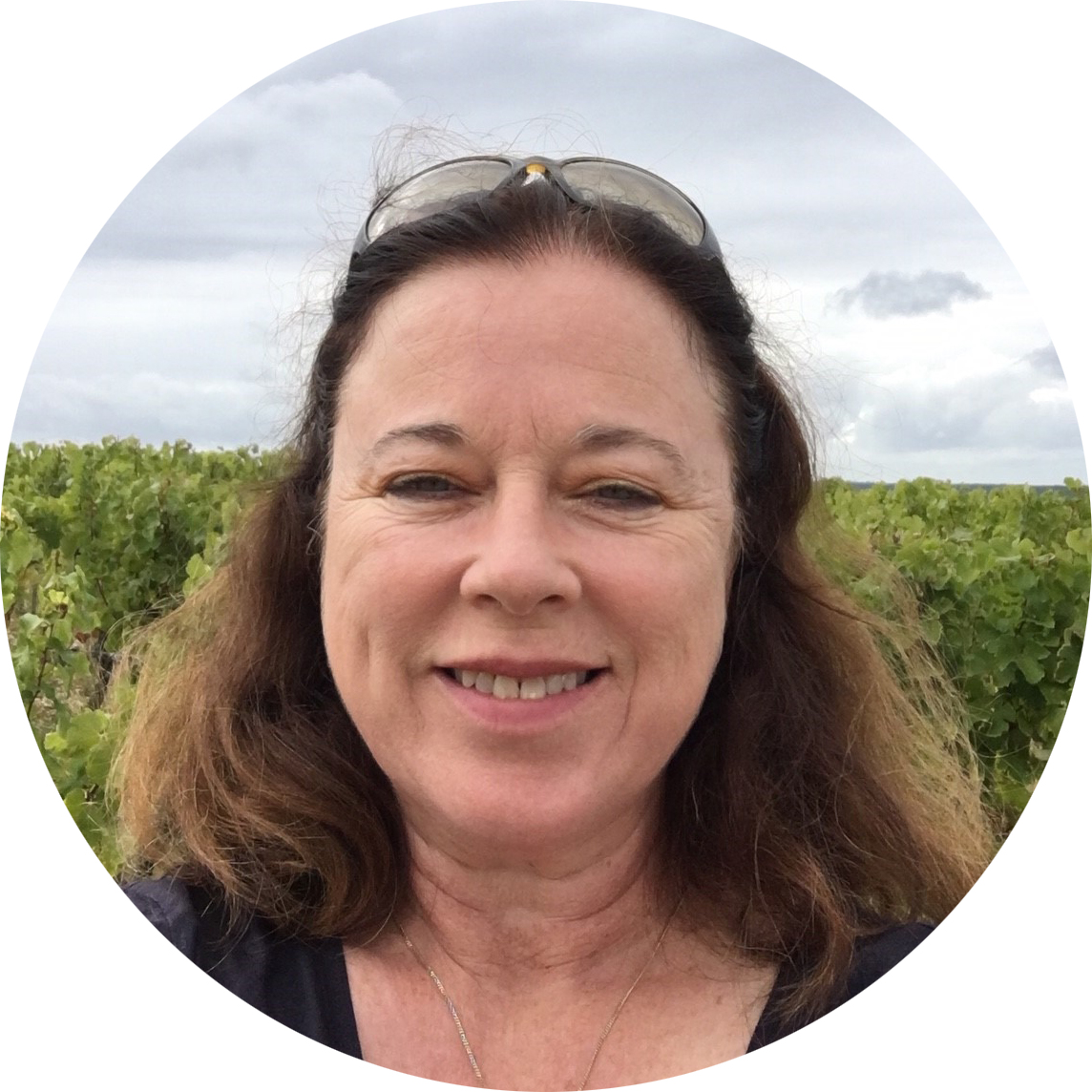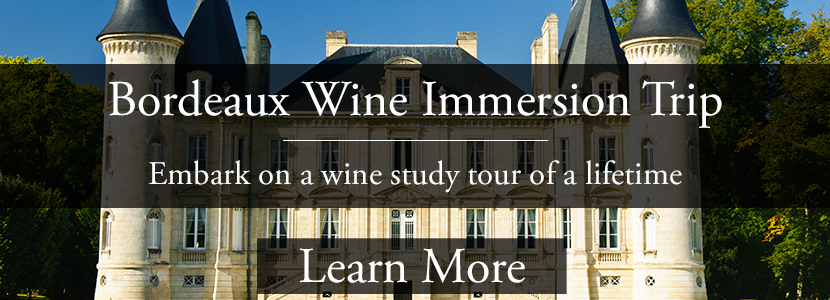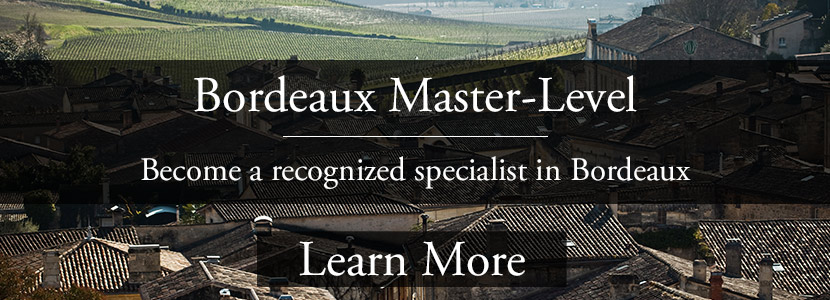BLOG
Sarah Graham-Beck reports live from our 2017 Bordeaux Wine Study Trip
Sarah Graham-Beck
Wine Culture

 Assisting trip instructor Gerard Basset MW, MS, our Tour Manager Sarah Beck-Graham reports daily on the learnings and encounters on our 2017 Bordeaux wine study trip taking place October 1st through 6th 2017.
Assisting trip instructor Gerard Basset MW, MS, our Tour Manager Sarah Beck-Graham reports daily on the learnings and encounters on our 2017 Bordeaux wine study trip taking place October 1st through 6th 2017.
Sarah lives in Bordeaux and has 15 years of experience in the Bordeaux wine industry. She has been manager of a top Right Bank chateau and worked for several top Bordeaux wine merchants. She now guides wine tours in the region and handles logistics for wine-related events.
DAY 1 - Margaux & St-Julien
Chateau Kirwan (Margaux):
The first visit of our very first day in Bordeaux took us to Chateau Kirwan, where we were welcomed by general manager Philippe Delfaut. He is a busy man at harvest time, but he gave us his undivided attention and peppered our minds with lots of ideas to ponder for the week.
Chateau Kirwan does alcoholic & Malolactic fermentations at the same time. They use special inoculations which enable warm & charged (with sediments & particules) wines to be put in barrel, with very successful results. This is a relatively new technique, first used by a Bordeaux Chateau around 2003.
Philippe surprised us with 10 day old Petit Verdot for an impromptu tasting in the cellars. The wine was a work in progress, the alcohol fermentation was complete, but the Malo had not quite finished. Philippe was expecting it to go into barrels in 10 days time. We then tasted some finished wines - the Chateau's second wine, Charmes de Kirwan 2010 and Chateau Kirwan 2012—perfection!
{os-gal-9}
Chateau d'Issan (Margaux) :
Our next stop at Chateau d'Issan where we were received by the sales director, Augustin.
It was the final day of harvest, workers were bringing in the last of the cabernet sauvignon destined for the Chateau's second wine. The group was enthralled with many fascinating stories about this chateau—its history goes back 800 years! Augustin held the tasting inside the chateau, which included the Blason d'Issan 2015 and the incredible chance to compare Chateau d'Issan 2015, 2010 & 2009!
{os-gal-10}
Chateau Léoville Barton (Saint Julien):
Chateau Léoville Barton welcomed us for lunch and we were personally greeted by Lilian Barton Sartorius. She co-owns the combined winery and chateau with her father. Lilian gave an engaging overview of the family history. Her descendents came to Bordeaux from Ireland as shippers, and started a négociant company. After the French revolution and napoleonic wars, a family member bought Langoa in the early 19th century. The family continues to aquire property, most notably Chateau Mauvesin Barton in Moulis has recently been purchased for the next generation of the family.
After our amazing barrel tastings of the estate's wines, we were shown to an elegant table set for an excellent (and copious) grape pickers' lunch. Our luncheon wines included chateau Mauvesin 2012, Chateau Langoa Barton 2008 & Chateau Leoville Barton 1999. During lunch our Sicilian-American wine scholar serenaded Lilian Barton with a sweet Italian song sung in a lovely voice! We finished the visit with a tour of the technical facilities.
{os-gal-11}
Chateau Beychevelle (Saint Julien):
We next went to Chateau Beychevelle where we were welcomed by general manager Philippe Blanc before our chateau guide Aude took us on a tour of heir stunning new technical facilities. Our group got to take lifts to the top of the vats to drop some grapes in. They've just two more days of harvesting to do!
Aude was sure to tell us the story of the chateau name, which means "sails lowered" in an old southwestern French dialect, in honour of an earlier owner, a 17th century admiral. We were again offered the chance to taste multiple vintages.
{os-gal-12}
Dinner with chef Philippe Etchebest:
Monday was brought to a heavenly gastronomic close with dinner at famous chef, Philippe Etchebest's new restaurant, Le Quatrieme Mur, in the magnificent north wing of Bordeaux's Opera House. Chef Etchebest even came round to greet Gerard Basset and our scholars.
The gorgeous meal was complemented by Chasse Spleen 2010, Sociando Mallet 2010 & a young Maury served with the chocolate dessert. What a day!
{os-gal-13}
DAY 2 - Pauillac
Chateau Pichon Baron (Pauillac):
We started day two at Chateau Pichon Baron and a visit with general manager Nicolas.
As we stood in the middle of the estate's vineyards surrounded by priceless vines, we heard an overview of the history of the two Pichons and of the role of current owener AXA millésimes.
The Pichon Baron Vineyard more than doubled in size after Axa purchased the estate! Nicolas also talked about vine management, which was so easy to understand while standing in a vineyard! The group then moved on to the technical facilities
We talked about current tests being administered to examine different processes for vat & barrel management. This is definitely not your average wine tour!
For the tasting we were joined by Corinne, the chateau communications director and the group got to experience a flight of 2015 wines, including Chateau Pibran, Les Tourelles, les Griffons and Chateau Pichon Baron. For the finale, we compared the 2010 and 2009 vintages of Chateau Pichon Baron. Wow!
{os-gal-14}
Chateau Latour (Pauillac):
Our next visit was in walking distance, so we walked across the road to 1st Growth, Chateau Latour.
Our tour began with a video looking at the daily life of Latour over a two-year period. Then it was out Into the vines to hear about the history of the Chaeau and their move to biodynamic farming. Then we were taken to the vat room, but not before vistting their storage room of one million bottles (a neccesity since chateau Latour has recently left the futures system)! The Chateau staff thoughtfully decanted our tasting wines an hour beforehand, so we really got to experience a heaping dollop of their true potential. The line-up included their Pauillac 2012, Forts de Latour 2011 and Chateau Latour 2004.
{os-gal-15}
Lunch at Cafe Lavinal:
Everyone was ready for lunch at the delightful Cafe Lavinal, in the Villages Bages next to Chateau Lynch Bages.
{os-gal-16}
Chateau Pichon Comtesse (Pauillac):
We were welcomed at our next stop by Nicolas Glumineau, general manager of Chateau Pichon Comtesse. We stood in the sunshine discussing differences of wine styles in great detail. Nicolas used to be a winemaker at Chateau Montrose so the conversation was especially informative and interesting. Balance, elegance & terroir were the most used words today!
Nicolas also talked about vineyard changes that he instigated and of the Chateau's new facilities. We tasted the Reserve de la Comtesse 2014 and 2011 and Chateau Pichon Comtesse 2014 and 2011. The word "stunning" comes to mind.
{os-gal-17}
Chateau Pontet Canet (Pauillac):
The drive to our next stop took us past some of Bordeax's most historical and prestigous chateaux, definitely setting the stage for our afternoon visit.
We were welcomed at Chateau Pontet Canet by the owner, Alfred Tesseron, who knew some of the members of our group!
Our guide Ava told us about the history of the chateau before we went into the vineyards to talk about biodynamic growing. Theirs is the only certified biodynamic estate in the Medoc's classified group, although Chateau Palmer is expected to be certified this year.
The estate works with eight horses, who can cover half of the vineyard. It takes time to train them, so they only get one extra horse per year. The vineyards are quite distinctive because the vines are trained in circles that are not trimmed but allowed to grow as naturally as possible. In the cellars they use natural yeasts and gentle pumping off. We were all very excited to see their famous cement egg-shaped fermenting vats, as well as the amphora used for ageing.
Alfred Tesseron rejoined the group for the tasting where he shared Pontet Canet 2008 and a sample of the 2016.
{os-gal-18}
DAY 3 - Graves and Sauternes
Chateau Haut Brion (Pessac Léognan):
The lineup for day three had everybody rife with excitement and anticipation. We passed by some of Bordeau's iconic sights on our way to Chateau Haut Brion as Gerard led a fascinating discussion of the history of Pessac Léognan and its white and red wines.
Justine welcomed us at Haut Brion with stories about the estate and its famous owners. After an introductory video, Barbara, the main guide, joined Justine for a technical overview and they explained their unusual two-part stainless steel vats. Then we got to meet the chateau's barrel maker, who was very patient with all of our questions.
The tasting was held in the estate's beautiful Orangerie and we got to compare the Chateau La Mission Haut Brion 2011 with the Chateau Haut Brion 2011. This visit could not have been more perfect.
{os-gal-19}
Chateau Smith Haut Lafitte (Pessac Léognan):
We had some extra time before our next appointment so we stopped at Pape Clement where we had an impromptu introduction with business development manager, Antoine Fanjat also a friend of a group member. He led a visit to the reproductions of the tomb of Pope Clement the 5th and the famous chapel.
Our official visit was at Chateau Smith Haut Lafitte, where we were welcomed by their guide, Florian. The group was led to the top of one of the chateau's towers where she gave an interesting talk about the history of the Chateau. It was an amazing view!
We then visited their barrel making facilities where the cooper makes a large percentage of what the winery needs.
In the technical facilities we began to talk about the white wines too! The Chateau is both high tech—using satellites & drones, but is also very traditional—using horses in the vineyards.
The group was awed as we tasted the Smith Haut Lafitte 2014 white wine and the Smith Haut Lafitte 2012 red wine.
{os-gal-20}
Lunch at La Table du Lavoir
The next stop was a lovely lunch at La Table du Lavoir with the following wines : Les Hauts de Smith White 2015 & Smith Haut Lafitte Red 2011
{os-gal-21}
Chateau Sigalas Rabaud (Sauternes):
As we drove to Sauternes, Gerard gave an overview of the history and special nature of these wines.
We drove past Ch d'Yquem and then we arrived at Ch Sigalas Rabaud just around the corner.
Laure (the owner) and her two sons (the seventh generation) gave us an overview of their location and history. The smallest of the premiers crus at 14ha, it is a real family estate.
Our first stop was into the vineyards with Laure and her sons as they spoke of the harvesting process. They explained the art of picking and discussed the low yields. It was quite evident that these wines are made in the vineyard, here the harvester is the winemaker.
We then went to see their vertical press before going on to a tasting in the Chateau. Laure makes a dry 100% Sémillon which we were able to compare with an older dry white with Sauv Blanc in the blend. We then got experience the wonderful sweet wines, starting with their aperitif No5 sweet wine and ending with the Grand Vin : see photos below!
{os-gal-22}
DAY 4 - Saint Emilion & Pomerol
Chateau Figeac (St Emilion)
Our visit to Bordeaux's right bank began with a warm welcome by Chateau Figeac's managing director and winemaker, Frederic Faye.
Chateau Figeac is the largest first classified growth in St Emilion and has been a family estate since 1892, although its history goes back to Gallo Roman times.
Unusual for St Emilion, Chateau Figeac employs a high percentage of Cabernet Sauvignon and Cabernet Franc—we found it to be the most Medoc-like Chateau of the Right Bank!
Our host explained St Emilion's soil types, which explained the grapes they used. Clay and limestone is found near the town while sand and clay is scattered elsewhere throughout the appellation, but at Figeac the soils are predominantly gravel.
In the cellar, the discussion turned to how vintage conditions affect what happens in the winery. For example, they purchased some smaller tanks this year because 70 percent of the vines were affected by this year's unfortunate frost. The group was able to witness the winemaking team at work as they were sulfur meshing in a barrel. Again, this was not the average wine tour!
One of the first chateau to produce a second label in 1945, the group tasted the Petit Figeac 2012 before the estate's crown jewel, the Figeac 2009.
{os-gal-23}
Chateau La Conseillante (Pomerol)
Chateau La Conseillante's winemaker Mireille Cazauz welcomed us to Pomerol, Bordeaux's smallest appellation. As we stood amongst the vines, she gave a super overview of vineyard management, bug control and Bordeaux's biggest challenge—mildew. Mireille also talked about the right bank's famous blue clay—so perfect for Merlot.
In the cellars she talked about the process of choosing the wines for the estate's grand vin and then about fermentation. The estate uses concrete vats for both fermentations, as they don't want to do the Malo in barrel because of the high use of water required. Chateau La Conseillante is very environmentally conscious.
The group was enthralled with the winemaking details as we tasted a 2016 barrel sample!
{os-gal-24}
Chateau Cheval Blanc (St Emilion)
At Chateau Cheval Blanc their famous winemaker Pierre Lurton came to say hello before Stephanie took us on a tour.
Chateau Cheval Blanc is one of the largest estates in St Emilion and the terroir is excellent for Cabernet Franc.The vineyard is found in a single area around the chateau, which is very rare in St Emilion. As we toured the vineyards, Stephanie pointed out some just-planted Cabernet Sauvignon vines and discussed Cabernet Franc clones. The estate works with six different types of Cabernet Franc clones, including their own, which they believe are better than commercially available versions.
Because of its small size, the vineyard is quite homogeneous, so a high proportion of the fruit goes into the Chateau's first wine. We also noticed that they use single cane pruning—unusual in Bordeaux.
The group was quite taken with their fabulous wave-like cellars built in 2011. The garden on top insulates the tank room, which minimizes energy use. Their unique patented tanks come in many sizes allowing them to be very precise with the picking time of different plots.
We happily tasted the Chateau Cheval Blanc 2011.
{os-gal-27}
Dinner at Le Chapon Fin
{os-gal-25}
DAY 5 - Côtes de Castillon, Pomerol
Domaine de l'A (Côtes de Castillon)
Domaine de l'A is the family property of Christine & Stephane Derenoncourt, who consults for properties around the world including many in St Emilion. Stephane said that he loves limestone, present here, which he thinks is the best soil in the world for Merlot. His estate is on the prolongation of the limestone côtes : astéries limestone which is very special, as roots can go inside. The fruit becomes flowers & spice and with age you get aromas of black truffles. Merlot, he thinks, on other soils is more simple.
His philosophy is that of a chef, and he has created his own school to develop talent.
He uses biodynamic vineyard management and makes picking decisions based on tasting the grapes. He doesn't sort a lot, as his idea is to increase complexity. He doesn't crush the grapes which causes the fermentation to be longer, which he noted that oenologists don't like, as they prefer to make it fast! Stephane thinks a longer fermentation of 3/4 weeks gives more complexity. He says his work is based on reflection & observation. He does a Burgundian style fermentation with open vats & pigeage. Indigenous yeasts (a risk that oenologists don't like either, he says). Stephane likes to age the wines on the lees, as the dead yeasts give fat/glycerine to the wine.
Just one racking is used and then the wine stays on lees for 15 months. with batonage early on. Roughly only 25% new oak is used, as Stephane feels it is enough. He uses medium-toast barrels, as too much toasting gives sugary characters.
Stephane thinks we have to keep our traditions and culture (people have been making wines for 6000 yrs) but we also need to be in our century too. However, he was sure to let us know that he thinks a wholly scientific approach is catastrophic but oenology has given us some good tools.
The line of bottles in the tasting room were from some of the estates where Stephane works as a consultant We also tasted the three last vintages of his estate. As Stephane said, "one of the best vintages (2015), one of the worst (2013) and a classic vintage (2014). This vertical showed us what can be done to make the best of any vintage. Even with 2013's bad weather and very, very low yields, the result was a good wine.
{os-gal-26}
Chateau Lafleur-Petrus (Pomerol)
The right bank is really a different world from the left. It is different in every way, especially here in Pomerol which could be called the "Burgundy" of Bordeaux.
Our hose Nathalie Miller led us on a tour of the estate. Located on the plateau of Pomerol, Chateau Lafleur Petrus is a marriage of Merlot and gravels.
We learned all about green harvesting and discovered that Christian Moueix is highly involved in the picking which is where grape selection is done. The estate concentrates on simple, classical winemaking to maintain balance & elegance. Our group tasted the wonderful 2015.
{os-gal-28}
Final lunch at l'Atelier de Candale
Our final lunch was at l'Atelier de Candale, a very pretty location surrounded by vines just beginning to take on the golds & colours of Fall.
{os-gal-29}
Access Your Free French Wine Scholar® Chapter Now!





